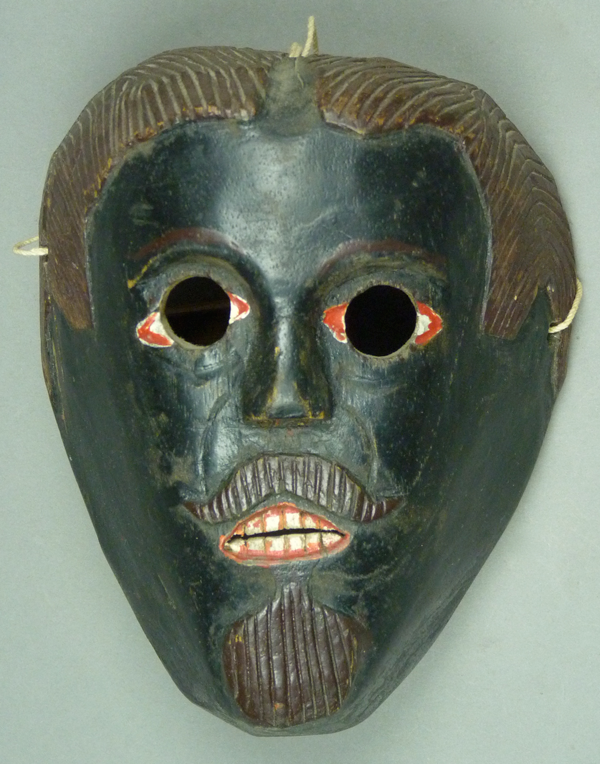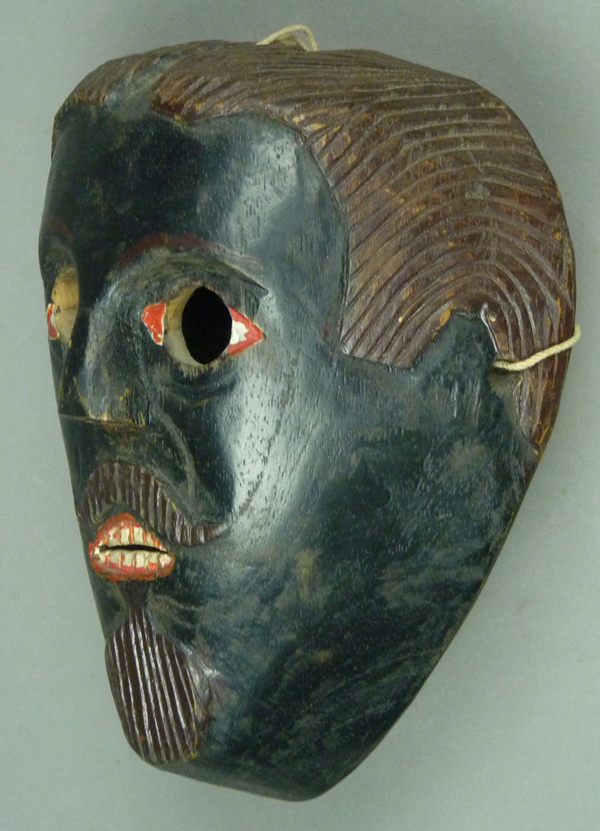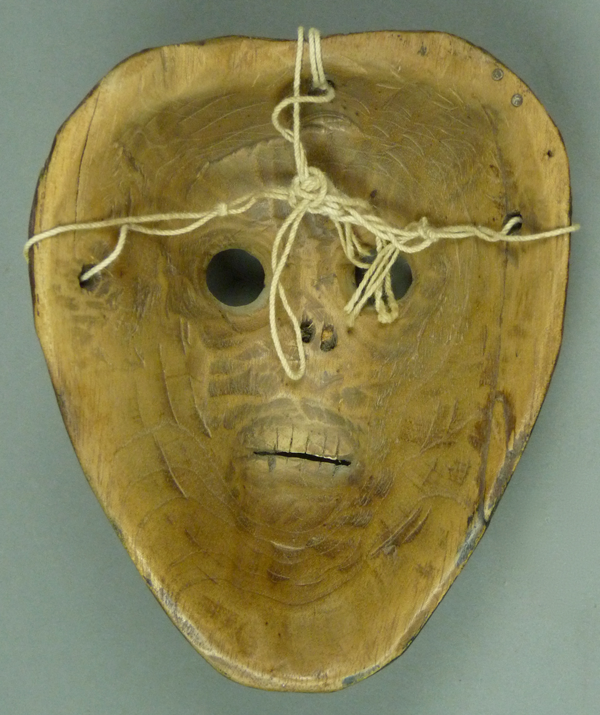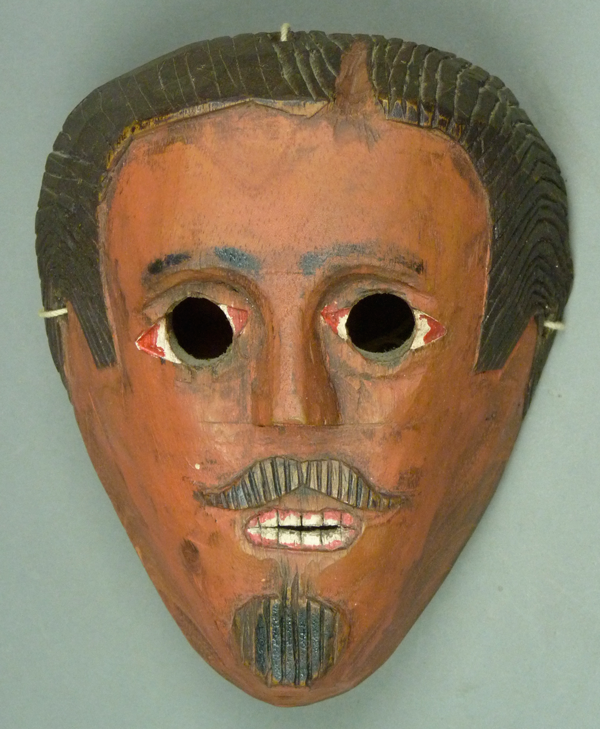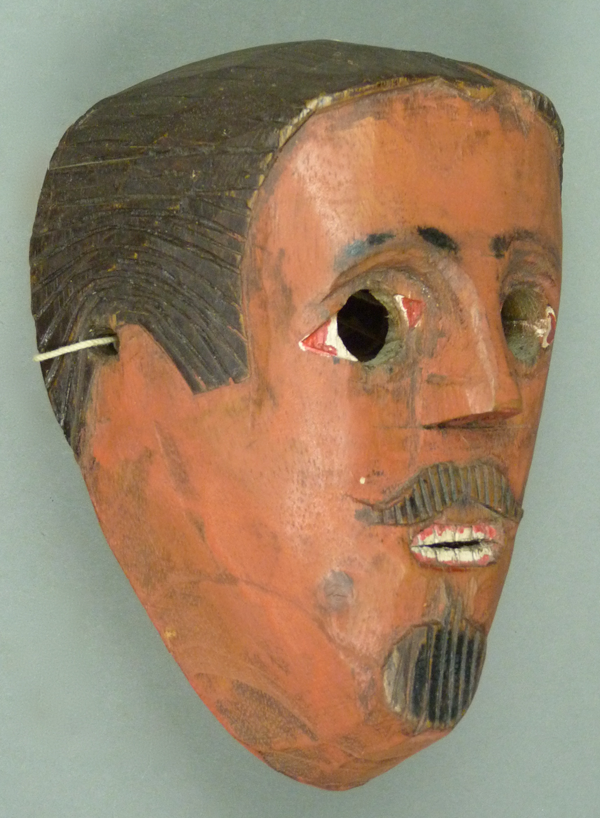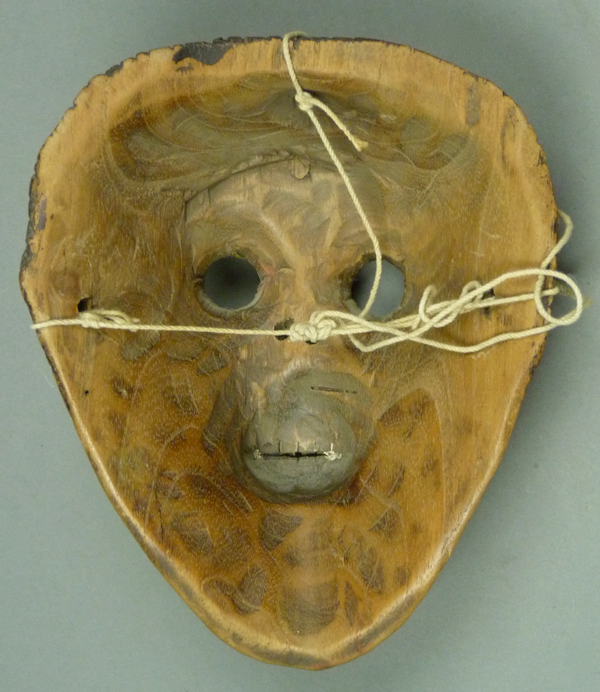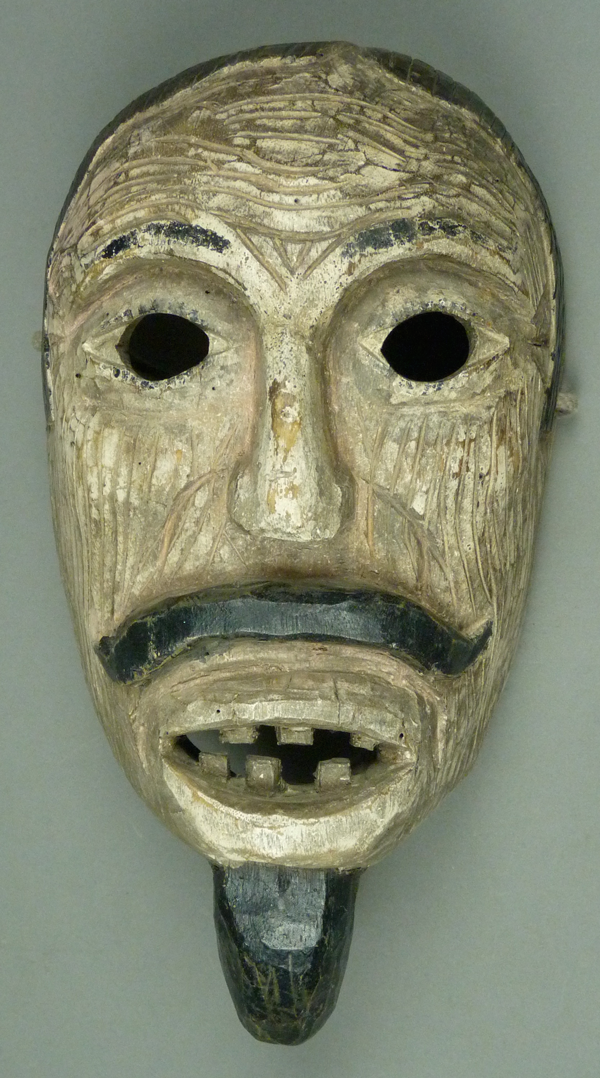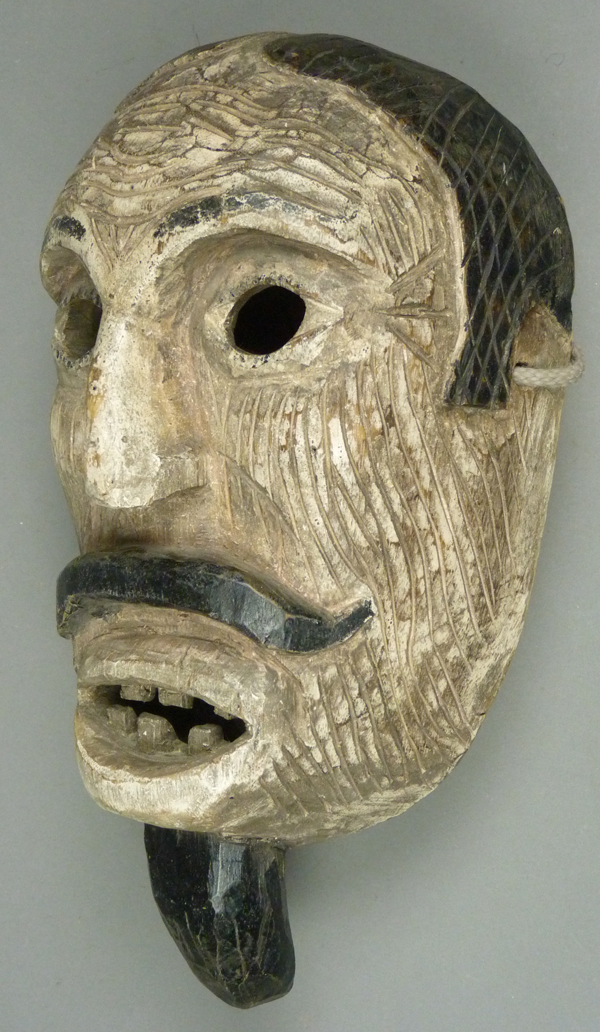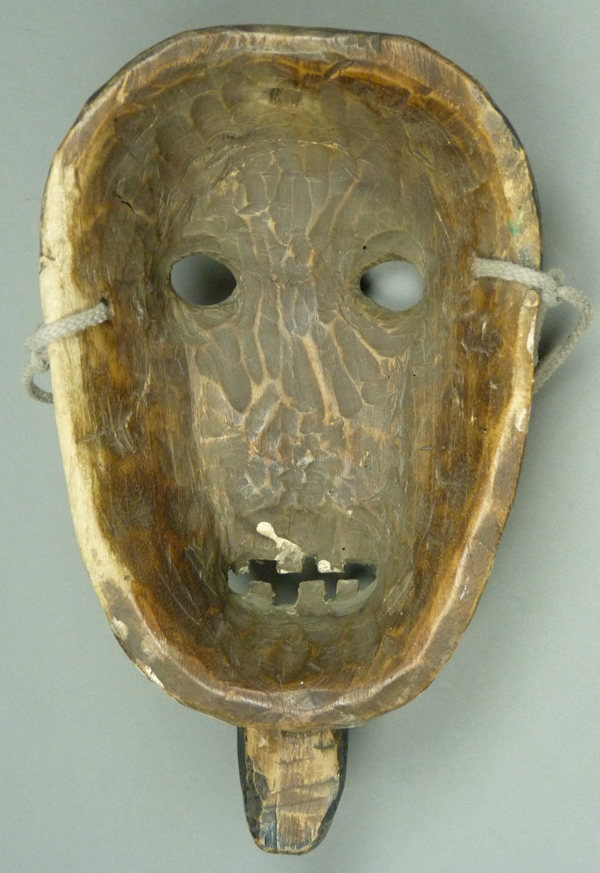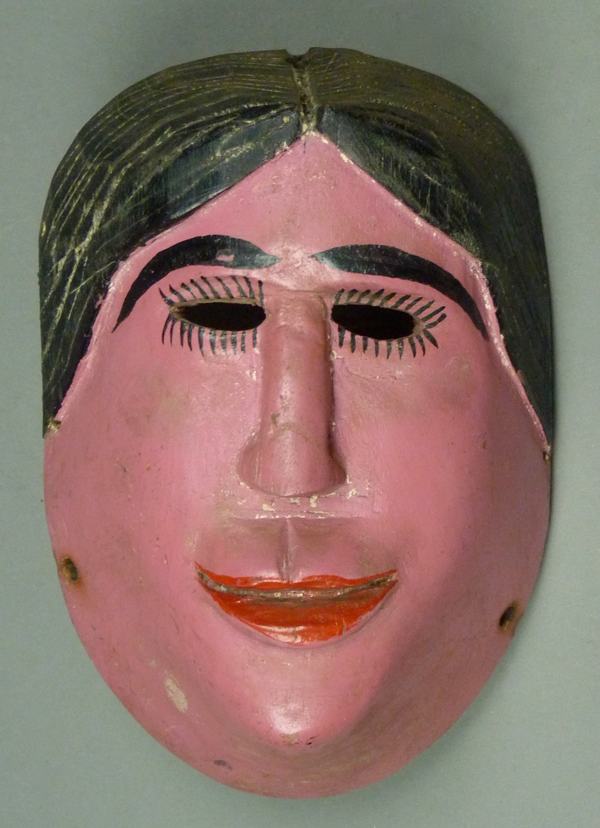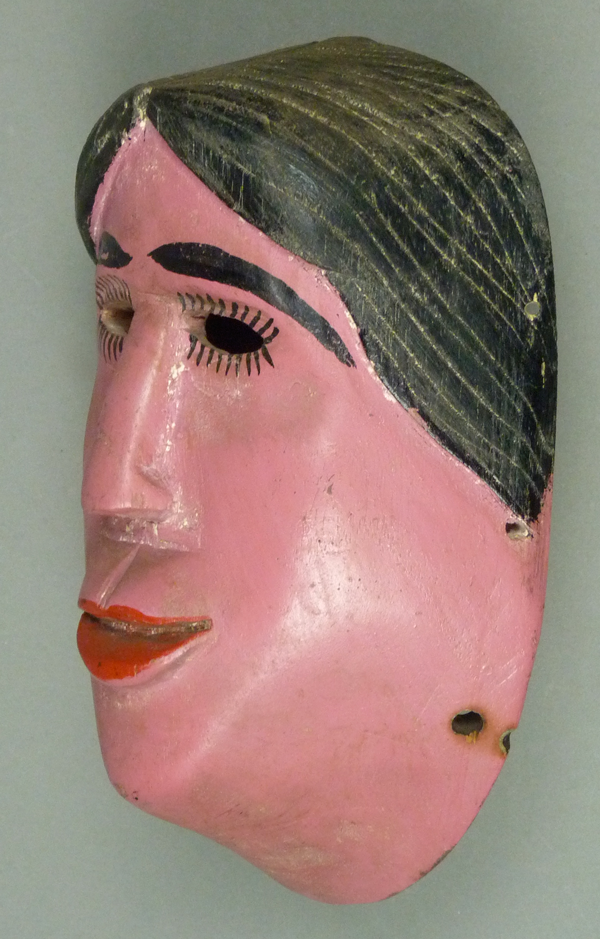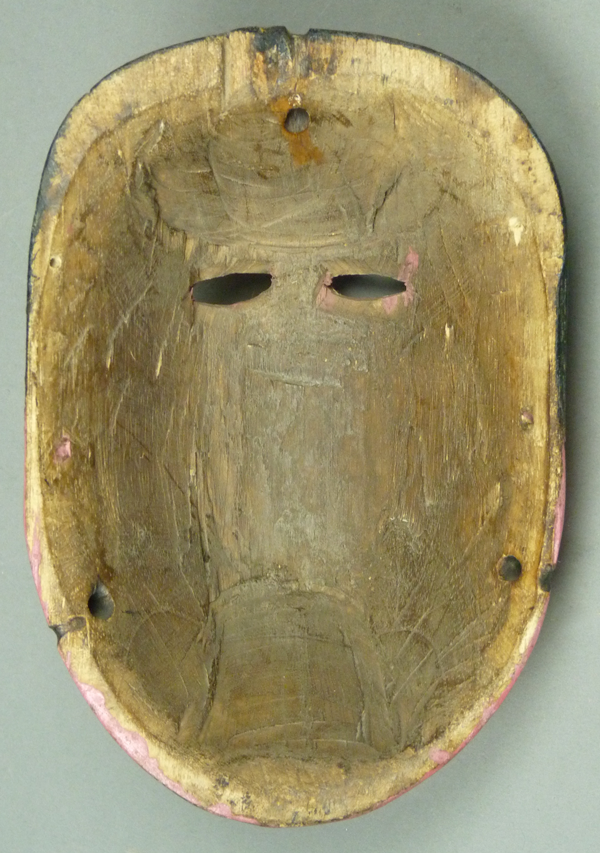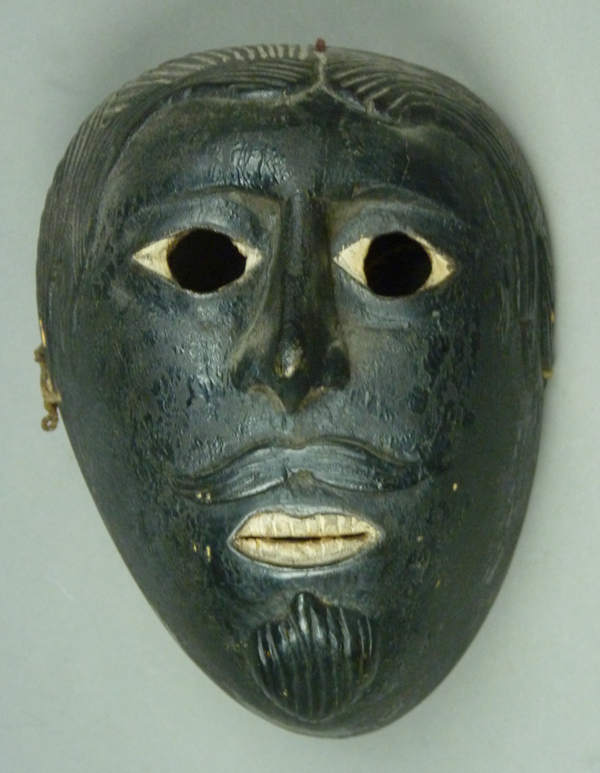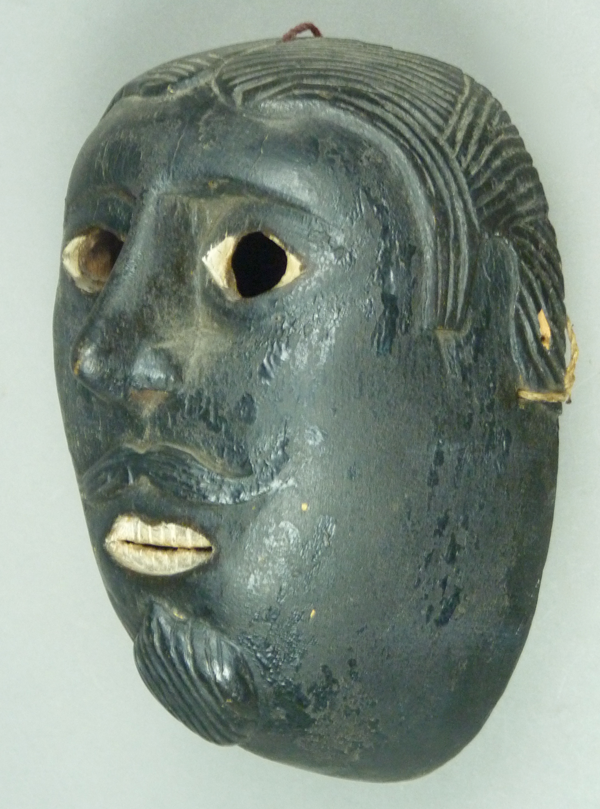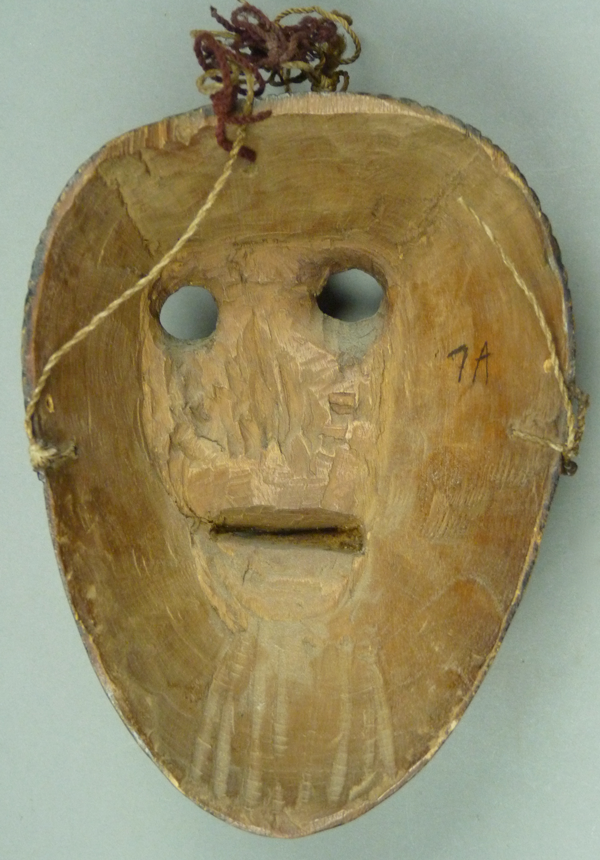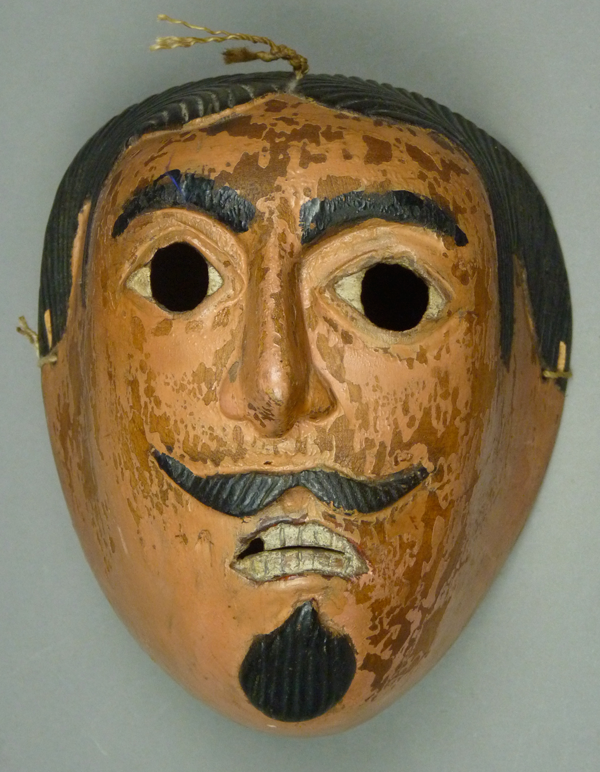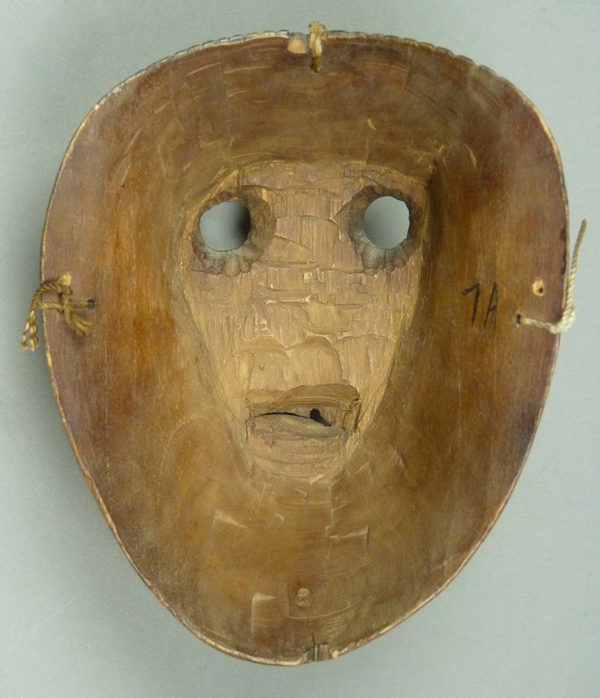According to the brief description that was provided by Jaled Muyaes and Estela Ogazón in Máscaras (1981, pages 90 and 92), the Danza de Juanegro (or Cuanegros) was derived from an earlier, precontact dance, Coatl Negro (Black Snake). In the Juanegro dance, Pañol (el Español, the Spaniard) or el Patrón (the hacienda owner) competes with Juan Negro, his black foreman, for the love of a woman. She flirts with each of them. The point of the dance is that the although the Spaniard should inevitably win such a power struggle, things don’t always turn out as one might expect. In Tigers, Devils, and the Dance of Life: Masks of Mexico (1999, pages 30 and 32), Barbara Mauldin reports that the desired female avoids marrying the Spaniard, waits for Juanegro to be emancipated, and then elopes with him. She also notes that this dancer usually wears a kerchief over her face in lieu of a more formal mask. Here is a traditional mask of Juan Negro.
I bought this Juan Negro mask, paired with a very similar mask of Pañol, in 1987, at the insistence of my friend, Barbara Cleaver. She underscored the remarkable patina, despite the reality that these masks were only danced during one fiesta each year—Todos Santos (All Souls or the Day of the Dead).
This old Juan Negro mask has classic features, such as the details of the relief carved hair—the hairline with part, the stereotyped sideburns, the opening for an invisible ear, and the grooving of the hair, mustache, and goatee. Also typical are the design of the eyes and the diminutive size. This mask is 6½ inches tall, 5¼ inches wide, and 2¾ inches deep.
The traditional Juanegro masks were carved from ceder. The lines that define the teeth are carried through to the back. The wear on this mask is dramatic.
A WORD OF WARNING—In recent years one finds what appear to be Juanegro mask imitations for sale, for instance on EBay™. If you are considering the purchase of a Juanegro mask, carefully compare the prospective purchase to the masks in these posts.
Here is the corresponding mask for Pañol, the hacienda owner.
One sees the same features, while the only substantial difference is the skin color.
The old original paint is thin from wear, so that the grain of the wood shows through. This is also the case for the Juan Negro mask. This mask is 6½ inches tall, 5½ inches wide, and 2½ inches deep.
Again one sees those little teeth, along with substantial wear.
Although I built up a collection of Juanegro masks over the next two decades, I never had the opportunity to witness them dancing. Recently I discovered that a number of Juanegro dance videos were available on YouTube™, permitting me to finally see these masks in action for the first time. I will begin with the first video that I discovered, from Ixcatepec, Veracruz, which was initially posted in 2007; I was thrilled to discover it in 2014! One detail to notice in this performance is the emphasis on rhythm in the dance; the musical instruments direct the dancers’ feet to pound out dramatic patterns.
https://www.youtube.com/watch?v=ifW2fghJr_I
I am including the next video to illustrate a charming aspect of this dance. Pañol and Juan Negro rest between bouts of dancing by sitting on their rifles as if these were stools. They brandish their guns and then they sit on them! Also notice that the “woman” (invariably portrayed by a man) in these versions wears neither a mask nor a kerchief over her face.
https://www.youtube.com/watch?v=WV7gcPCqB4A
Watching additional videos, I learned some new things—in some versions there are four dancers and of those, three usually wear masks. In addition to Pañol and Juan Negro, the third masked dancer is el Viejo (old one) or el Abuelito (grandfather). No published description mentions the Viejo in the dance, but he appears to be a symbol of agriculture as he rummages in a sack of seeds to scatter them on a field. Also, the woman in the dance can be called Malinche.
The context for this dance is the Fiesta for Todos Santos, the time of year when the souls of the dead visit their living relatives; it would seem that the Juanegros dance for the living and for their visitors.
Here are links to two additional videos that include the masked Viejo dancer. In the first, there is extensive commentary in Spanish. The Viejo appears at about 1:10 in the video.
https://www.youtube.com/watch?v=-P_E45HIoQw
In the second video, the Viejo is obvious with his shoulder bag of seed. The mask worn by the Viejo in the second example is completely different from the one worn in the first, while the Pañol and Juan Negro masks vary little from one video to the next.
https://www.youtube.com/watch?v=bReOzaNcHfc
The next video, titled “Xantolo Juanegro,” reminds us again that although the Juanegro dance may appear to stand alone, in the Huasteca it is actually an element in the celebration of Todos Santos (Day of the Dead) and it occurs at no other time during the year. In the next video the Juanegro dance resembles a Xantolos performance, where lines of male and female dancers are meant to personify the visiting and often grotesque dead. The Xantolos dancers represent the souls of figures who died long ago, making them the recognizable emissaries of the invisible souls who are thought to accompany them on their annual visit. Such variation increases my suspicion that the Juanegro dancers also represent the dead.
In this version the woman does wear a kerchief over her face. The Pañol and Juan Negro dancers don’t seem to be carrying guns or whips, there are two dancers wearing Juan Negro masks, and two Malinches. In the bright sunlight, one of the Juan Negro masks looks momentarily like the face of a skull.
https://www.youtube.com/watch?v=s8NvX3k1NTg
By now you may have noticed that although I am a collector of individual masks, I prefer to collect dances—groups of related masks. In 2002 I bought an usual mask from the Cleavers. Although it was much larger than the Pañol and Juan Negro masks, it appeared to have been carved either by the same hand or from within the same tradition. This mask measures 10 inches tall, 6 inches wide, and 3¾ inches in depth, compared to 6½ inches x 5½ inches x 2½ inches for the earlier Pañol. It also differs from the typical Juanegro masks because of the prominent carved wrinkles on its face; it was said to be a Huehue, a word that often serves as a synonym for Xantolo, referring to the dancers who impersonate the dead during Todos Santos. However, when I discovered the Viejo actor in these videos, I realized that my “Huehue” mask could have been worn by this Viejo. Here it is.
The eye design, the hairline, and the grooving of the hair all remind one of the Juanegro masks.
On this mask the skin is grooved in the manner that the hair, mustache, and beard are grooved on the Juanegro masks. The more fully open mouth and the goatee are the only features that are distinctly different (along with the size).
This is another mask with considerable age and wear.
Meanwhile there had been another new development. In 2001 Jaled Muyaes showed me a mask that had been worn by the female character in the Juanegro dance. Even though the female usually dances without a mask, Jaled and his wife Estela discovered there have been communities where she did have a mask of her own. Here is one of those masks that was collected by Jaled and Estela.
Her smiling face reminds us that this figure flirts with both Pañol and Juan Negro; which one will she choose?
Her hair is grooved like that of her suitors, but with less precision than what we saw on the first old pair of masks. This mask measures 7 inches tall, 4½ inches wide, and 2¼ inches deep, virtually the same size as the Juanegro masks.
This mask has a typical pattern of staining from use; it was indeed danced.
I will end this post with a second old and traditional Juanegro pair that I obtained from Jaled Muyaes and Estela Ogazó in 2000. These two greatly resemble the first set, yet each of the four masks is different from the rest in some details.
I particularly like the pattern of grooving of the hair. Also note how neatly the goatee has been carved. This is a magnificent old mask.
This mask is 7 inches tall, 5 inches wide, and 3 inches deep.
The back shows moderate wear.
Here is the Pañol. Does his grimace portend his ultimate defeat by Juan Negro?
As noted earlier, the pattern of grooving of the hair on these two masks is elegant. The noses of this pair are carefully shaped.
This mask is 6¾ inches tall, 5½ inches wide, and 3¼ inches deep.
This back too shows moderate wear.
Next week we will look at Juanegro masks in a different style.

